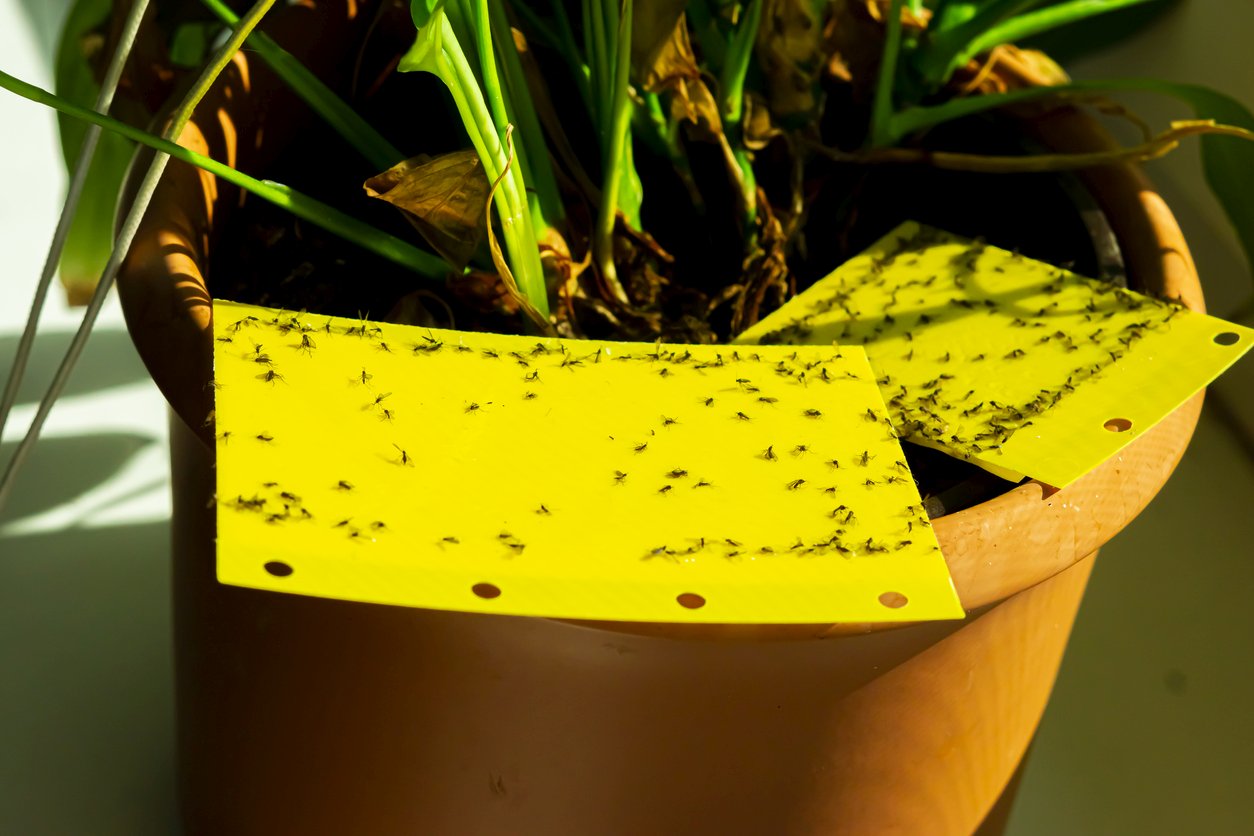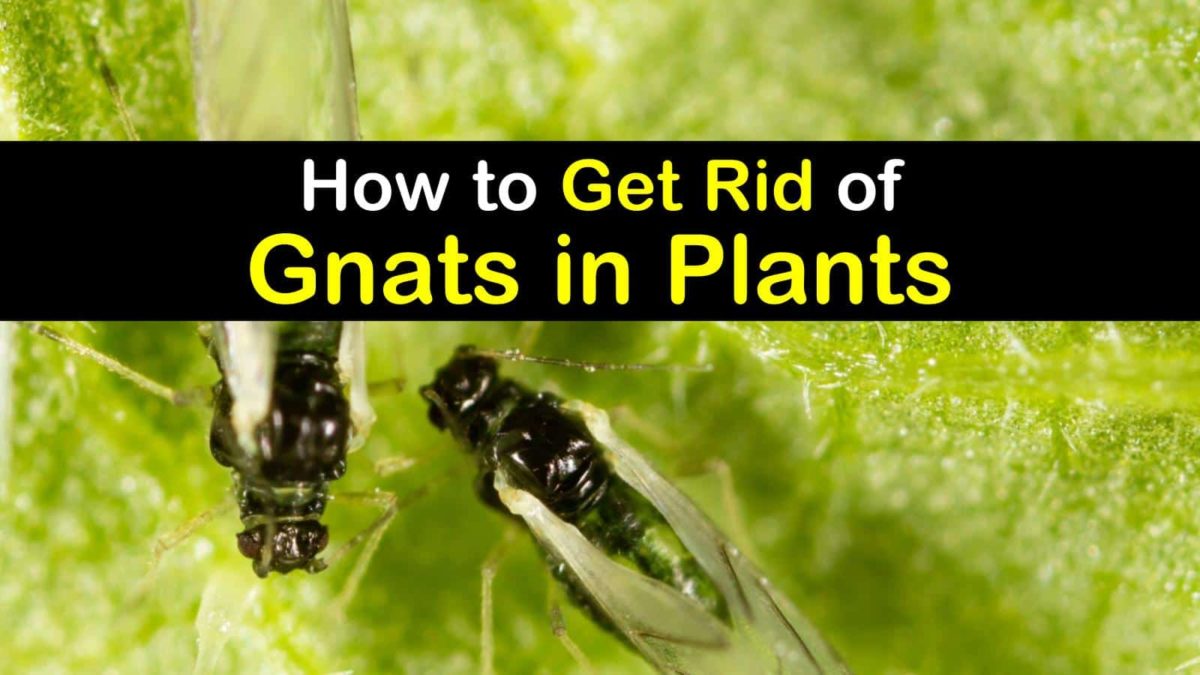Step-by-Step Instructions to Get Rid of Gnats in Plants: Tiny, pesky gnats can quickly turn your beloved houseplants into a breeding ground. These flying insects can be a nuisance, but with the right knowledge and techniques, you can effectively control and eliminate them.
This guide provides a comprehensive approach to understanding gnats, implementing preventative measures, and employing both natural and chemical control methods.
Gnats are attracted to moist environments, making overwatered plants a prime target. Their life cycle is short, with eggs hatching into larvae that feed on decaying organic matter in the soil. Recognizing signs of an infestation, such as tiny flying insects, wilting plants, and yellowing leaves, is crucial for early intervention.
This article will delve into a range of strategies to tackle gnat infestations, from simple preventative measures to more advanced control methods.
Understanding Gnats

Gnats are tiny, flying insects that can be a nuisance in homes and gardens. While they are not typically harmful to humans, they can be annoying and may even damage plants. Understanding the different types of gnats, their life cycle, and the signs of an infestation can help you effectively get rid of them.
While you’re working on getting rid of those pesky gnats, don’t forget to enhance your living space with stunning greenery! Check out our guide on Stunning Hanging Plants to Transform Your Living Room for inspiration. Once you’ve tackled the gnats, you can create a beautiful, vibrant indoor oasis with these gorgeous hanging plants.
Types of Gnats
Gnats are a diverse group of insects, but some common types that infest plants include:
- Fungus Gnats:These are small, dark gnats with long legs. They are attracted to moist soil and decaying organic matter, making them common in houseplants. Fungus gnats feed on fungi and algae, which they find in potting soil.
- Shore Flies:Also known as sewage flies, these gnats are attracted to damp areas, such as sinks, drains, and wet soil. They are often seen hovering around water sources.
- Fruit Flies:These are small, yellowish gnats with red eyes. They are attracted to ripe fruit and fermenting organic matter. Fruit flies can be a common problem in kitchens and pantries.
Life Cycle of Gnats
Gnats typically undergo a complete metamorphosis, with four stages: egg, larva, pupa, and adult.
- Eggs:Gnats lay their eggs in moist soil, decaying organic matter, or water.
- Larvae:The eggs hatch into small, worm-like larvae that feed on fungi, algae, or organic matter.
- Pupa:The larvae eventually pupate, forming a hard, brown shell.
- Adult:Adult gnats emerge from the pupae and begin to reproduce.
Signs of a Gnat Infestation
There are several signs that can indicate a gnat infestation in your plants:
- Flying Gnats:The most obvious sign is seeing gnats flying around your plants.
- Black Spots on Soil:The larvae of fungus gnats leave behind black spots on the soil surface.
- Wilting Plants:Gnat larvae can damage plant roots, leading to wilting.
- Yellowing Leaves:Gnat larvae can also damage plant leaves, causing them to yellow.
Prevention Strategies

Preventing gnat infestations in your plants is crucial to maintaining healthy and vibrant greenery. By adopting proactive measures and implementing preventative strategies, you can minimize the risk of these pesky insects invading your indoor and outdoor spaces.
While battling gnats in your plants, consider adding some beautiful hanging baskets to your outdoor space. These can add a touch of color and life to your porch or patio, while also providing a haven for beneficial insects that help control pest populations.
For inspiration on the best hanging plants for summer, check out this comprehensive guide: The Best Outdoor Hanging Plants for Summer. Once you’ve selected your plants, you can focus on eliminating those pesky gnats and enjoying your vibrant outdoor oasis.
Proper Soil Drainage and Overwatering
Proper soil drainage is paramount in preventing gnat infestations. Gnats are attracted to moist environments, and overwatering creates ideal breeding grounds for them. When soil remains excessively wet for extended periods, it becomes a breeding haven for gnat larvae.
- Ensure that your plant pots have drainage holes to allow excess water to escape.
- Use well-draining potting mix that allows for proper aeration and water flow.
- Water your plants only when the top inch of soil feels dry to the touch. Avoid overwatering, as it can lead to root rot and create an inviting environment for gnats.
- Allow excess water to drain from the pot after watering, and empty any saucers or trays that collect water.
Natural Repellents
Natural repellents can be effective in deterring gnats and creating an unfavorable environment for them. These methods are eco-friendly and safe for both humans and pets.
- Essential Oils:Certain essential oils, such as peppermint, lavender, and tea tree oil, possess insect-repelling properties. Dilute a few drops of essential oil in water and spray it around your plants. The strong scent can help deter gnats from approaching.
- Diatomaceous Earth:This natural, powdery substance is made from fossilized diatoms. When applied to the soil surface, it creates a sharp, abrasive barrier that dehydrates and kills gnats.
- Yellow Sticky Traps:Yellow sticky traps are effective in capturing flying gnats. The bright yellow color attracts the insects, and the sticky surface traps them. Place these traps near your plants to monitor gnat activity and capture any that may be present.
Natural Control Methods

Natural methods offer a safe and eco-friendly approach to controlling gnats in your plants. These methods are often effective, particularly when combined with preventative measures.
Natural Control Methods for Gnats, Step-by-Step Instructions to Get Rid of Gnats in Plants
Method |
Effectiveness |
Potential Downsides |
|---|---|---|
Diatomaceous Earth |
Highly effective in killing gnats and their larvae by dehydrating them. |
Can be dusty and irritating to the skin and lungs. |
Neem Oil |
Disrupts the life cycle of gnats and repels them. |
Can be harmful to beneficial insects and may need to be reapplied frequently. |
Apple Cider Vinegar Trap |
Attracts and traps gnats. |
May not be as effective as other methods and can attract other insects. |
Yellow Sticky Traps |
Effective in catching adult gnats. |
May not eliminate the source of the infestation and can be visually unappealing. |
Predator Mites |
Predatory mites feed on gnats and their eggs. |
May not be effective in all situations and can be expensive. |
Homemade Gnat Traps
Homemade gnat traps can be an effective and affordable way to reduce gnat populations. Here are a few recipes:
- Apple Cider Vinegar Trap:Fill a shallow dish with apple cider vinegar and add a few drops of dish soap. The soap breaks the surface tension of the vinegar, preventing gnats from escaping. Place the trap near your plants.
- Fruit Trap:Place a piece of overripe fruit, such as a banana or melon, in a shallow dish. The fruit will attract gnats, which will then be trapped in the dish.
- Wine Trap:Similar to the fruit trap, a small dish of red wine can attract and trap gnats.
Yellow Sticky Traps
Yellow sticky traps are a simple and effective way to catch adult gnats. The bright yellow color attracts gnats, and the sticky surface traps them. You can purchase pre-made yellow sticky traps or create your own by coating a piece of yellow cardboard with a sticky substance like petroleum jelly or honey.
- Advantages:
- Easy to use and readily available.
- Effective in capturing large numbers of gnats.
- Non-toxic and safe for pets and children.
- Limitations:
- Only capture adult gnats, not larvae.
- May not be effective in heavily infested areas.
- Can be visually unappealing.
Chemical Control Options
If you’ve tried all the natural methods and are still struggling with gnats, chemical control options might be your next step. However, it’s crucial to use these cautiously, as they can potentially harm your plants and the environment.
Insecticidal Soap
Insecticidal soap is a readily available and relatively safe option for controlling gnats. It works by disrupting the cell membranes of the insects, leading to dehydration and death.
- Apply the soap solution directly to the plants, ensuring thorough coverage of the foliage and soil surface.
- Avoid using insecticidal soap during hot weather, as it can damage the plant’s leaves.
- Repeat the application every few days until the gnat population is under control.
Insecticidal soap is generally safe for use around pets and children, but it’s always best to consult the product label for specific instructions and precautions.
Types of Chemical Insecticides
There are various chemical insecticides available for gnat control, each with its own advantages and disadvantages.
- Pyrethroidsare synthetic insecticides derived from chrysanthemum flowers. They are effective against a wide range of insects, including gnats. However, they can be harmful to beneficial insects and may cause resistance in pests over time.
- Neonicotinoidsare a class of insecticides that act on the nervous system of insects. They are highly effective against gnats but have been linked to bee decline and other environmental concerns.
- Organophosphatesare broad-spectrum insecticides that are highly toxic to insects. They are not recommended for use on houseplants or in enclosed spaces due to their potential toxicity to humans and pets.
Risks and Drawbacks of Chemical Insecticides
Using chemical insecticides can pose several risks and drawbacks:
- Toxicity to Plants: Some insecticides can damage plant foliage or inhibit growth.
- Toxicity to Beneficial Insects: Chemical insecticides can harm beneficial insects like ladybugs and lacewings, which help control other pests.
- Environmental Contamination: Chemical insecticides can contaminate soil, water, and air, potentially harming wildlife and ecosystems.
- Resistance: Overuse of chemical insecticides can lead to the development of resistance in pests, making them less susceptible to the insecticide in the future.
- Human Health Risks: Some chemical insecticides can be toxic to humans, causing skin irritation, respiratory problems, or even neurological damage.
It is essential to use chemical insecticides sparingly and only as a last resort. Always follow the manufacturer’s instructions carefully and take necessary precautions to minimize risks.
Closure: Step-by-Step Instructions To Get Rid Of Gnats In Plants
By understanding the habits and vulnerabilities of gnats, you can effectively prevent and control infestations in your plants. This guide has Artikeld a comprehensive approach, encompassing preventative measures, natural control methods, and chemical options. Remember, integrated pest management, combining various techniques, is key to achieving sustainable and long-term gnat control.
With a little knowledge and effort, you can keep your plants thriving and free from these pesky insects.
Essential Questionnaire
What are the most common types of gnats that infest plants?
The most common types of gnats found in houseplants include fungus gnats, shore flies, and fruit flies.
How long does it take for gnat eggs to hatch?
Gnat eggs typically hatch within 48 hours, depending on the temperature and humidity.
Can gnats harm my plants?
While gnats don’t directly harm plants, their larvae can damage roots by feeding on them, leading to stunted growth and wilting.
Are gnats harmful to humans?
Gnats are not known to transmit diseases or bite humans. However, they can be a nuisance and cause discomfort.
